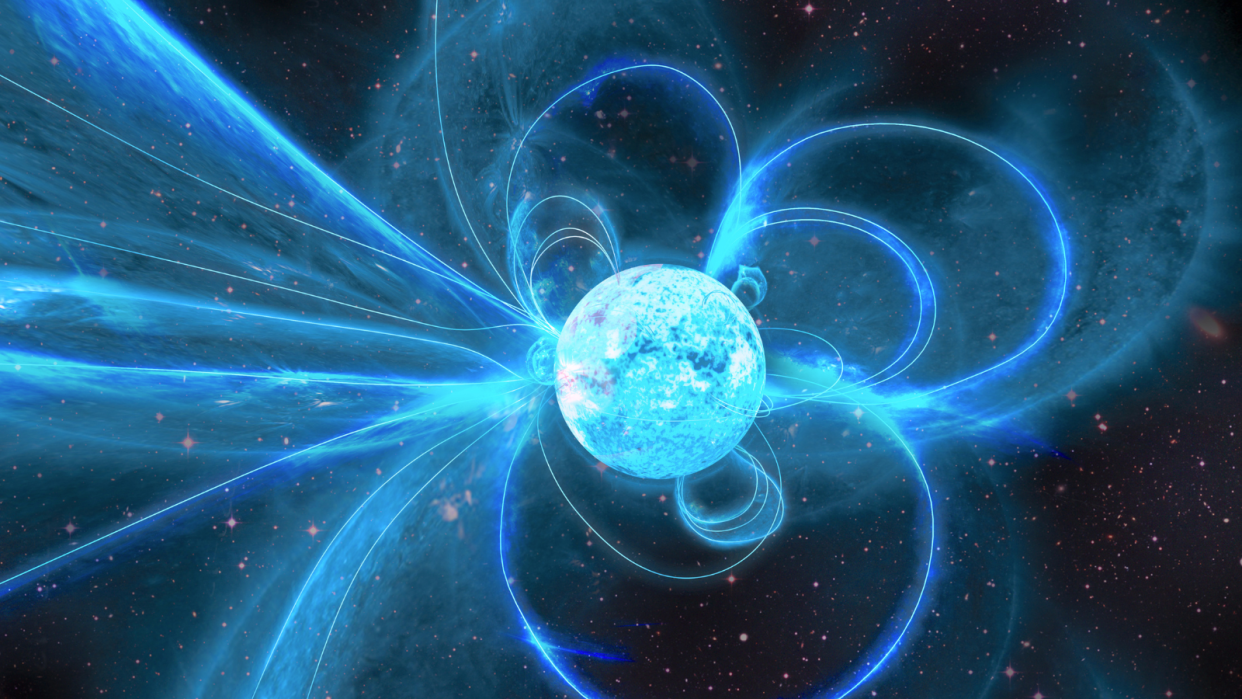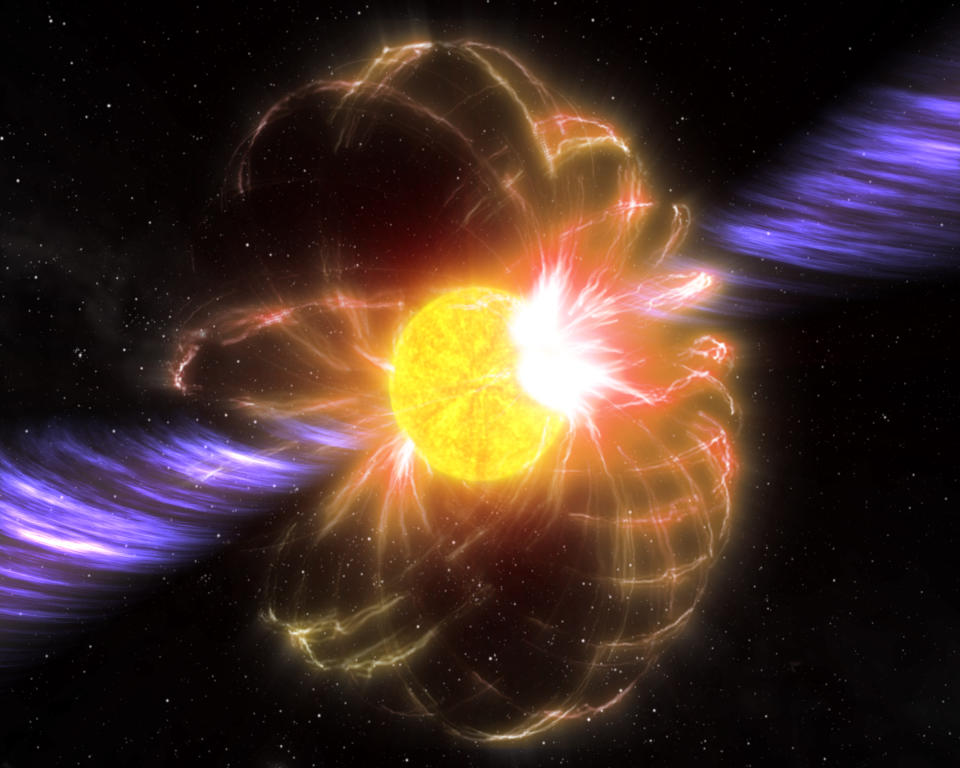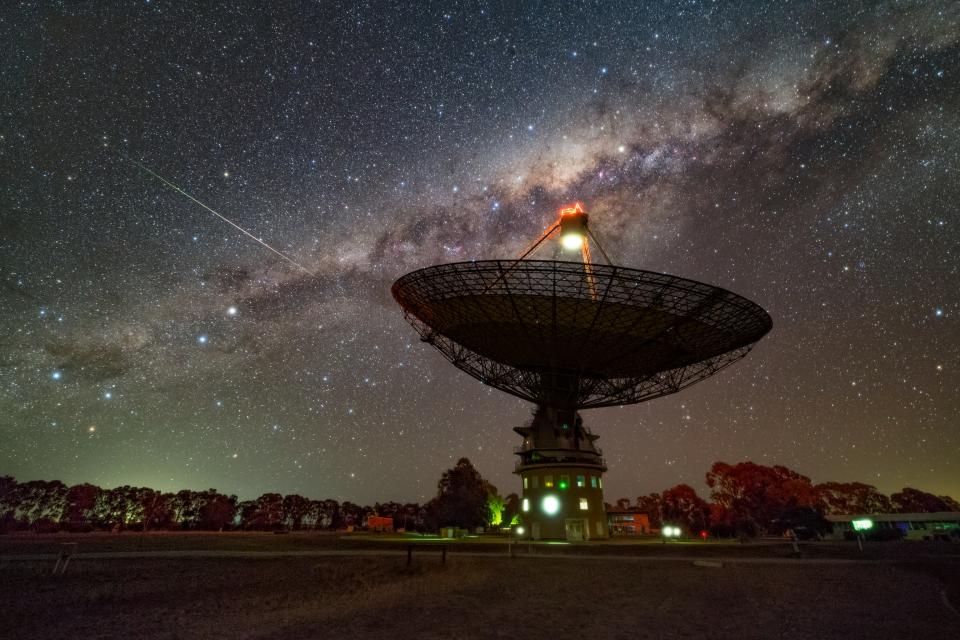One of the universe's most 'extreme' dead stars just sprang back to life unexpectedly

The universe's most extreme stars just got a little bit more unexpected and mysterious.
Scientists were astounded when they witnessed a "dead" neutron star with one of the most powerful magnetic fields in the cosmos unexpectedly spring back to life. The reactivation of this highly magnetic neutron star or "magnetar" doesn't conform to the current understanding of these exotic celestial objects.
The team made the discovery of this magnetar's return from the dead when they spotted strange radio signals from the closest known magnetar to Earth, XTE J1810-197, located around 8,000 light-years away, using the Australian Commonwealth Scientific and Industrial Research Organisation (CSIRO) Parkes radio telescope, Murriyang.
Most magnetars are known to emit polarized light, light with waves orientated in one particular direction. The team's findings show that the light this magnetar is circularly polarized, appearing to spiral as it moves through space. This is not only unexpected, it's also totally unprecedented.
Related: 'Vampire' neutron star blasts linked to jets traveling at near-light speed
"Unlike the radio signals we've seen from other magnetars, this one is emitting enormous amounts of rapidly changing circular polarization," team leader and CSIRO scientist Marcus Lower said in a statement. "We have never seen anything like this before."
XTE J1810-197 extreme even for a magnetar
We have never seen anything like this before."
Magnetars, like all neutron stars, are born when massive stars die. When these stars exhaust their fuel for the nuclear fusion of hydrogen to helium in their cores, the energy that has supported them against the inward push of their own gravity is cut off.
As the tug-of-war between gravity and radiation pressure ends after millions of years, the outer layers of the star are launched outward by a supernova explosion, resulting in the dying star losing the vast majority of its mass.
This leaves a stellar core with a mass between one and two times the mass of the sun, collapsing to a width of around 12 miles (20 kilometers), around the size of an average city on Earth. As a result, the matter that composes a neutron star is so dense that if a mere teaspoon of it were brought to Earth, it would weigh 10 million tons.
The rapid core collapse also causes the neutron star to greatly increase its rate of rotation, just like an ice skater drawing in their arms to increase their spin but on a vastly greater scale. This means some newly formed neutron stars can spin as fast as 700 times per second.
The collapse of this stellar core has another consequence. The magnetic field lines of the dying star are squashed together, causing the strength of the magnetic field to intensify. As a result, some neutron stars have magnetic fields that are a quadrillion (1 followed by 15 zeroes) times more powerful than the magnetic field of the sun. This qualifies these neutron stars for their own category, magnetars.

The detection of radio wave pulses from magnetars is incredibly rare, with XTE J1810-197 being just one of only a handful of known magnetars to produce them. XTE J1810-197 was first seen emitting radio waves in 2003, but then this magnetar fell silent for over a decade.
The magnetar was seen emitting radio waves again in 2018 by the University of Manchester's 76-m Lovell telescope at the Jodrell Bank Observatory. This was followed up with Murriyang, located in Wiradjuri Country, Australia, which has been observing XTE J1810-197 ever since.
Though this observation is completely unexpected, the team has an idea why this magnetar may be generating such unusual emissions.
"Our results suggest there is a superheated plasma above the magnetar's magnetic pole, which is acting like a polarizing filter," Lower said. "How exactly the plasma is doing this is still to be determined."

The 64-meter telescope Murriyang is outfitted with a cutting-edge ultra-wide bandwidth receiver, designed by CSIRO engineers, that is highly sensitive to changes in brightness and polarisation across a broad range of radio frequencies. This helps gather precise measurements of a range of celestial objects, especially magnetars.
RELATED STORIES:
— A new approach might help scientists see inside a neutron star
— Dead star 'glitches' could reveal the origins of fast radio bursts
— The heaviest neutron star ever observed is shredding its companion
The researchers hope that continued observations of XTE J1810-197 with Murriyang will help provide insights into a range of extreme, powerful, and unusual magnetar-related phenomena, such as plasma dynamics, bursts of X-rays and gamma-rays, and potentially fast radio bursts.
The team's research was published in the journal Nature Astronomy.

